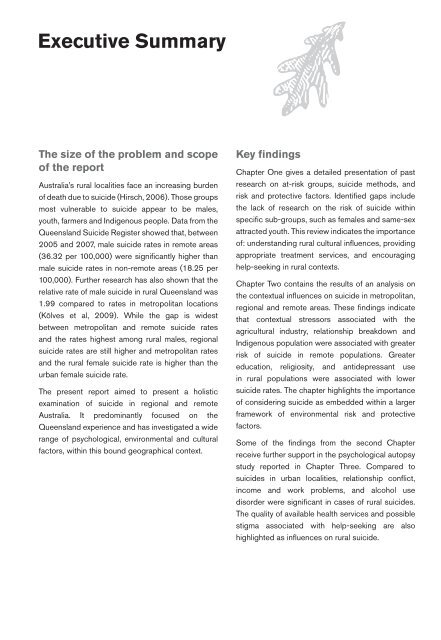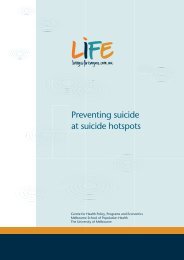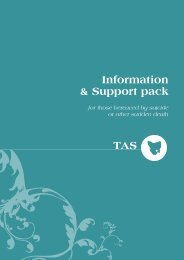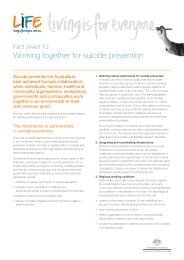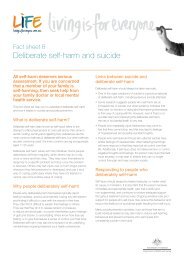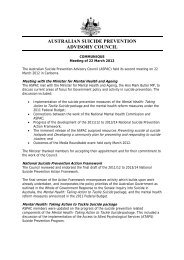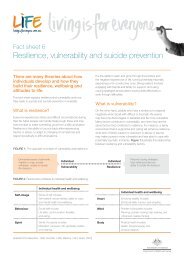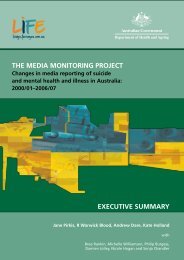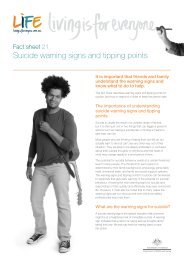SUICIDE in RURAL & REMOTE AREAS of AUSTRALIA - Living is for ...
SUICIDE in RURAL & REMOTE AREAS of AUSTRALIA - Living is for ...
SUICIDE in RURAL & REMOTE AREAS of AUSTRALIA - Living is for ...
Create successful ePaper yourself
Turn your PDF publications into a flip-book with our unique Google optimized e-Paper software.
Executive Summary<br />
The size <strong>of</strong> the problem and scope<br />
<strong>of</strong> the report<br />
Australia’s rural localities face an <strong>in</strong>creas<strong>in</strong>g burden<br />
<strong>of</strong> death due to suicide (Hirsch, 2006). Those groups<br />
most vulnerable to suicide appear to be males,<br />
youth, farmers and Indigenous people. Data from the<br />
Queensland Suicide Reg<strong>is</strong>ter showed that, between<br />
2005 and 2007, male suicide rates <strong>in</strong> remote areas<br />
(36.32 per 100,000) were signifi cantly higher than<br />
male suicide rates <strong>in</strong> non-remote areas (18.25 per<br />
100,000). Further research has also shown that the<br />
relative rate <strong>of</strong> male suicide <strong>in</strong> rural Queensland was<br />
1.99 compared to rates <strong>in</strong> metropolitan locations<br />
(Kõlves et al, 2009). While the gap <strong>is</strong> widest<br />
between metropolitan and remote suicide rates<br />
and the rates highest among rural males, regional<br />
suicide rates are still higher and metropolitan rates<br />
and the rural female suicide rate <strong>is</strong> higher than the<br />
urban female suicide rate.<br />
The present report aimed to present a hol<strong>is</strong>tic<br />
exam<strong>in</strong>ation <strong>of</strong> suicide <strong>in</strong> regional and remote<br />
Australia. It predom<strong>in</strong>antly focused on the<br />
Queensland experience and has <strong>in</strong>vestigated a wide<br />
range <strong>of</strong> psychological, environmental and cultural<br />
factors, with<strong>in</strong> th<strong>is</strong> bound geographical context.<br />
Key f<strong>in</strong>d<strong>in</strong>gs<br />
Chapter One gives a detailed presentation <strong>of</strong> past<br />
research on at-r<strong>is</strong>k groups, suicide methods, and<br />
r<strong>is</strong>k and protective factors. Identifi ed gaps <strong>in</strong>clude<br />
the lack <strong>of</strong> research on the r<strong>is</strong>k <strong>of</strong> suicide with<strong>in</strong><br />
specifi c sub-groups, such as females and same-sex<br />
attracted youth. Th<strong>is</strong> review <strong>in</strong>dicates the importance<br />
<strong>of</strong>: understand<strong>in</strong>g rural cultural <strong>in</strong>fl uences, provid<strong>in</strong>g<br />
appropriate treatment services, and encourag<strong>in</strong>g<br />
help-seek<strong>in</strong>g <strong>in</strong> rural contexts.<br />
Chapter Two conta<strong>in</strong>s the results <strong>of</strong> an analys<strong>is</strong> on<br />
the contextual <strong>in</strong>fl uences on suicide <strong>in</strong> metropolitan,<br />
regional and remote areas. These fi nd<strong>in</strong>gs <strong>in</strong>dicate<br />
that contextual stressors associated with the<br />
agricultural <strong>in</strong>dustry, relationship breakdown and<br />
Indigenous population were associated with greater<br />
r<strong>is</strong>k <strong>of</strong> suicide <strong>in</strong> remote populations. Greater<br />
education, religiosity, and antidepressant use<br />
<strong>in</strong> rural populations were associated with lower<br />
suicide rates. The chapter highlights the importance<br />
<strong>of</strong> consider<strong>in</strong>g suicide as embedded with<strong>in</strong> a larger<br />
framework <strong>of</strong> environmental r<strong>is</strong>k and protective<br />
factors.<br />
Some <strong>of</strong> the fi nd<strong>in</strong>gs from the second Chapter<br />
receive further support <strong>in</strong> the psychological autopsy<br />
study reported <strong>in</strong> Chapter Three. Compared to<br />
suicides <strong>in</strong> urban localities, relationship confl ict,<br />
<strong>in</strong>come and work problems, and alcohol use<br />
d<strong>is</strong>order were signifi cant <strong>in</strong> cases <strong>of</strong> rural suicides.<br />
The quality <strong>of</strong> available health services and possible<br />
stigma associated with help-seek<strong>in</strong>g are also<br />
highlighted as <strong>in</strong>fl uences on rural suicide.<br />
GriffithBook FINAL 20/09.<strong>in</strong>dd 1<br />
15/11/12 4:28 PM


